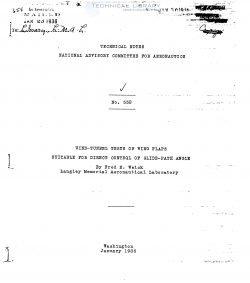naca-tn-552
- Version
- 112 Downloads
- 504.65 KB File Size
- 1 File Count
- November 25, 2016 Create Date
- November 25, 2016 Last Updated
National Advisory Committee for Aeronautics, Technical Notes - Wind Tunnel Tests of Wing Flaps Suitable for Direct Control of Glide Path Angle

Preliminary tests have been made in the N.A.C.A. 7—
by 10—foot wind tunnel for the purpoae of obtaining a
flap arrangement suitable for direct and immediate control
of the steepness of the glide path of an airplane, a use
for which present flaps are not satisfactory. An attempt
has been made to‘develop a flap giving a reasonably high
maximum lift coefficient with relatively low deflection
and maintaining this value of the maximum lift coefficient
with a large increase of deflection, the increase in de—
flection being accompanied by a large increase in drag.
An arrangement was found that gave a maximum lift coeffi—
cient of approximately 1.90 for all flap deflections be—
tween 250 and 80°, within which range the drag of the
wing increased regularly to a larg.e value.
The usual high—lift flaps increase the drag in larger
proportion than they increase the lift and they can there—
fore be used to increase the angle of glide in an approach
to a landing. They do not, however, give satisfactory and
instantaneous control of the flight—path angle because the
use of the flaps ordinarily involves a change of Speed,
and therefore of kinetic energy, that tends to give a mo—
mentary action in the opposite direction to that desired.
For example, as the flap is extended to increase the steep—
ness of descent the lift increases and the airplane ordi~
narily attains a new balance at a lower speed. The kinetic
energy associated with the speed_loss is dissipated by
lifting the airplane from its original flight path, and it
travels a matter of several hundred feet before the actual
flight path crosses the projection of the original path
and the glide is changed in the desired manner. Conversely,
if the airplane is gliding steeply at low speed with the _
flap extended and an attempt is made to flatten by retract~
ing or neutralizing the flap. the lift is reduced and the
speed increases until a hechenditi n ef.balance is
reached; the airplane in_this_case drops_below the projec-
tion of its original flight path until it has traveled a
distance of several hundred'feet; 'Thus theJTlaps are not
in themselves suitable to give direct control of the glid~
ing angle but are merely useful"(iniadditihn.'of course,
to giving a reduction in the minimum speed available) in
converting a medium or lowedragzairplane into one having a
higher drag and consequently a steeper glide.
| File | Action |
|---|---|
| naca-tn-552 Wind Tunnel Tests of Wing Flaps Suitable for Direct Control of Glide Path Angle.pdf | Download |
Comment On This Post